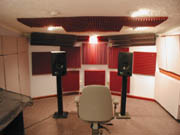
Question: I am a drummer. I keep my drum set in my basement. My wife would rather not hear me practice, so I decided to try to reduce the sound transmission from the basement to the upstairs. I have looked on the Internet for sound proofing material and found a lot of products-most of them expensive. The problem is, I can't afford these products. What other options do I have to lower the noise level upstairs without paying for these expensive tiles and foams? I have heard that putting carpet on the basement ceiling will work. Is this true? Could I buy any type of foam from a foam manufacturer that's not "sound-proofing foam?"
Answer: Probably the best solution would be to build a practice room in the basement. Start by building a floating floor, which can be just a floor placed on rubber sheeting. Then build a suspended drywall ceiling, suspended from the basement ceiling with fiberglass or rubber shock absorbers. Place fiberglass insulation between the suspended ceiling and basement ceiling. Finally, build two sets of walls (one surrounding the other) around the periphery of the floor and ceiling. Ventilate the room separately from the rest of the house so sound can't escape the room through air vents and into the upstairs. Seal all construction gaps with caulking so sound can't escape through cracks.
If you do this yourself, make sure the construction meets local building codes. Remember the 100 who lost their lives in the Rhode Island nightclub fire and do not use any materials that aren't appropriately fire rated.
We recently purchased our first condo in a historical building and it has wooden floors. When we purchased it, there were no neighbors on top of us. Now there are and it is really noisy. There is vibration when they walk and we can hear their voices. They do not want to put a carpet in the bedroom. Is there anything we can do to insulate our bedroom ceiling from their floor (like making a hole in the ceiling and inserting some insulation materials)?
Usually, a project like this would require removing your ceiling completely and replacing it with an insulated, heavy double-layered ceiling suspended from resilient mountings. The object is to not have a common joist between the floor above and the ceiling below.I repaired some plaster some time ago that was lath and plaster backed. Since I no longer live at the property, I can no longer check for the existence of asbestos. Was asbestos added to loose plaster? I appreciate it is hard to tell without testing. The property was fairly old-pre-1900. However, I have no idea if the plaster was original.
As far as I know, asbestos was typically only added to plaster intended to be acoustic plaster. This would not be a common requirement for a residence. Of course, individual plasterers may have had their own formulations, which included asbestos. Asbestos tests are inexpensive and the only way to be sure.We are seeking technical information and products that have the best acoustical properties. Is gloss paint better? What sort of carpet will do the least damage to acoustics?
Each project is different and requires a unique selection of materials to obtain the acoustics that the owners want. Since there are infinite design combinations and many opinions on what sounds good, each product can't be described as good or bad. Each product is simply another building block. A good acoustic design results from a good combination of building blocks. Visit www.ncac.com to find a consultant.I am searching for a building material that I can install between wood studs of existing walls to reduce transmission of conversations between rooms.
I don't believe you will find anything to go between wood studs that will reduce the sound transmission between rooms by more than 3 decibels. The problem is that the sound vibrates the wallboard on one side of the wall and this vibration is telegraphed through the studs to the wallboard on the other side of the wall, where it produces a carbon copy of the sound in the next room. Placing materials in the cavity only absorbs sound within the wall cavity.We moved into a new home and have a serious problem with vibration. Not only does the home seem to resonate with local traffic, we typically have a steady hum. We need to be able to measure, identify the source of the vibration, the reason the house resonates, and come up with a solution-or move (haven't slept through the night in four months).
To track down an unidentified noise, first keep a record of the following:- Who hears the noise
- An estimate of the pitch of the noise
- When is the noise loudest and quietest
- Is the noise more like a note or a hiss, and
- Where is the noise loudest and quietest?
If only one or two people hear the noise, it is a good idea to have those people get a medical and hearing check up. Some hearing self-noise can be symptoms of disease.
If no medical problems exist, then it's time to track down the source. Low-frequency noise travels far and is difficult to locate due to the long wavelengths. The frequency of noise may help in locating its source.
For example, one person compared his noise to the D note two octaves below middle C on the piano. From music tables, this note is about 73 Hertz. Do a search for 73 Hz on the Internet and you can find:
- The normal wing stroke frequency of the bumblebee is 73 Hz (any nests in the house?)
- The percussion frequency of the Superdrifter COP 1838HF high frequency hydraulic rock drill is 73 Hz (locate the nearest mining operations)
- A common scan frequency of video cards and monitors is 73 Hz (Unplug your computer and see if it goes away).
Locating low-level, low frequency noise will likely require the help of an acoustician with specialized equipment. The search cannot be done with a simple sound-level meter. As difficult as finding the source can be, this is usually only half the battle. Noise ordinances are generally poorly written and/or unenforceable. Most offensive noisemakers are only interested in hiding behind the minimal requirements.
Although one can improve the sound insulation in a house, low frequency noise is very expensive to shield against. The massive size of these waves tends to envelope the house and causes the entire structure to vibrate in unison.
Earplugs are not effective in blocking low frequency sound; the wave is simply too big. Some people find relief using white noise generators to mask the offensive sound.
If noise pollution were coal smoke, this would be the 1950s. High ambient noise is widely considered as just a necessary inconvenience of industrial progress.
How is your work with Harmony School and the open plan school concept? What feedback have you received?
Harmony School moved to a different site in 2002 but kept the open plan concept. At that time, they were facing financial and legal problems associated with Ohio's alternate schools program and acoustics was necessarily on the back burner.
Open plan will never meet the Classroom Standards for Acoustical Performance (ANSI S12.60-2002). However, a "second-best solution" may be found in which speech intelligibility is not the prime directive but is still optimal. Certainly, noise from adjacent class areas is the big problem with open plan and many open plan teachers have complained about this. Then again, many open plan teachers have compelling reasons for promoting open plan. I'm no expert in education, so I'll leave their reasoning for others to judge. It seems to me that each measure of a classroom, be it acoustic, openness or what, has an associated benefit and, depending on the building variables unique to one project, there exists a set of optimal measurements which produces the greatest overall benefit.
I have a problem with loud, inconsiderate neighbors from upstairs who walk heavily and enjoy tapping on the floor at all times of the day and night. How can active noise control help in my situation? I haven't been able to find any ANC device to attach to the walls and ceilings. Headphones are quite difficult to wear while sleeping and earplugs are uncomfortable. I haven't had much sleep since they moved in.
Unfortunately, there is no "Fenton Silencer" that can cancel noise like you are describing. ANC is only useful for reducing periodic noise whose wavelength is greater than the space to be treated. It is most effective for small spaces (the space between the ears of a helicopter pilot wearing ANC headphones) and low frequencies (the blade frequency of a helicopter's main rotor). It is somewhat effective for slightly larger spaces (inside a car) when the listener (driver) and low frequency source (engine) do not move around. It is not effective at all for anything larger.
Quiet living spaces require a concerted demand for quiet living spaces. Only when landlords lose money by not providing quiet will there be incentive enough to provide them. Demand a "quiet clause" on your next lease.
What are the future of acoustics and the usefulness of reverberation time?
Reverberation time is a 100-year old metric used in an attempt to summarize the quality of the acoustics of a space. It survives because of the vast amount of data collected on preferred RTs for various sizes and types of space.The original RT formula was developed to design and predict the RT for a given space, starting with an assumption of total diffusion. Improvements to RT formulae have added the effects of various complications. The result is a set of equations, each one for a specific set of conditions. In the immediate future, a "grand unified" RT formula is needed, which is universally applicable to all spaces. The equation would need to simplify to each of the specific equations for the conditions they cover.
Realizing that RT is a made up metric, it is destined to be replaced by a more realistic measure of acoustic performance. This measure will likely be nine dimensional and good or bad acoustics will be characterized by the shape of this nine-dimensional metric.



Report Abusive Comment